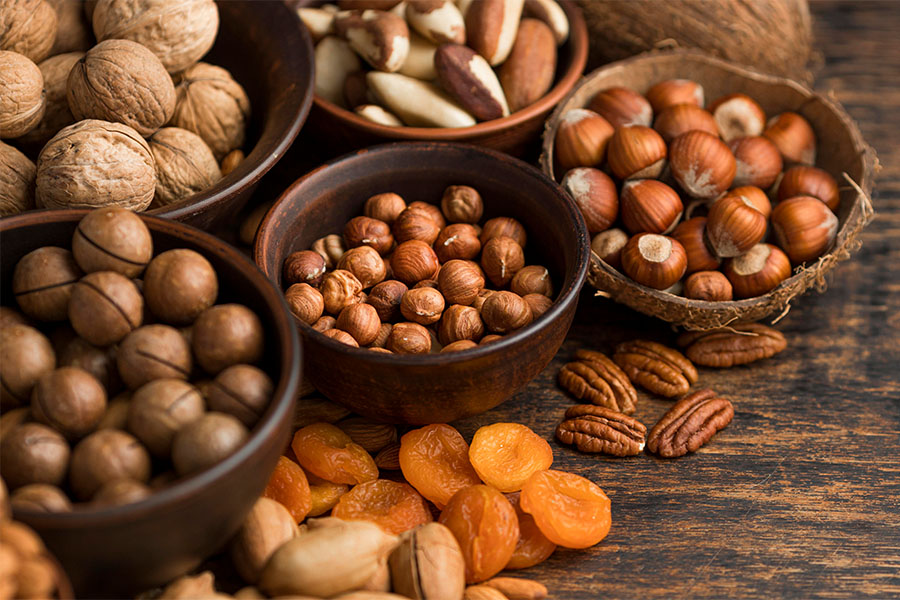Nuts are a popular snack and an essential ingredient in many cuisines around the world. They are also highly nutritious and packed with essential vitamins, minerals, and healthy fats. However, it can be challenging to tell whether the nuts we are buying are fresh or not. In this article, we will discuss some tips and tricks to help you identify fresh nuts.
-
Check the expiration date:
The first step to identifying fresh nuts is to check the expiration date. Most nuts have a shelf life of about 6-12 months, depending on the type of nut and how it is stored. Look for the “best by” or “use by” date on the packaging and make sure it is not expired. If the nuts are already past their expiration date, it’s best to avoid buying them.
-
Look for physical signs of freshness:
Another way to tell whether nuts are fresh is to look for physical signs of freshness. Fresh nuts should have a bright color and a smooth, unblemished surface. If you see any discoloration, mold, or spots on the nuts, it’s a sign that they are not fresh. Additionally, the nuts should feel firm to the touch and should not be soft or mushy.
-
Smell the nuts:
Fresh nuts should have a mild, nutty aroma. If you notice a sour or rancid smell, it’s a sign that the nuts are not fresh. The smell is often an indicator of how long the nuts have been sitting on the shelves or in storage.
- Taste
the nuts:
One of the best ways to tell whether nuts are fresh is to taste them. Fresh nuts should have a mild, nutty flavor and a crispy texture. If the nuts taste stale or have a rancid flavor, it’s a sign that they are not fresh. You can also try breaking the nuts open to see if the inside is dry or moist.
- Buy from
a reputable source:
Finally, it’s important to buy nuts from a reputable source. Choose a store that has a high turnover rate for nuts, so you know they are not sitting on the shelves for too long. Additionally, if you can, buy nuts that are sold in bulk so that you can inspect them before purchasing.
storing nuts at home
When storing nuts at home, it’s crucial to store them properly to ensure their freshness. Nuts should be kept in an airtight container and stored in a cool, dry place, away from direct sunlight or heat. Exposure to heat and light can cause the oils in the nuts to go rancid and spoil their flavor. It’s also a good idea to store nuts in the refrigerator or freezer to extend their shelf life. Nuts can be stored in the refrigerator for up to six months and in the freezer for up to a year.
When using nuts in recipes, it’s important to taste them before adding them to the dish. If the nuts taste stale or rancid, it’s best to discard them and use fresh nuts instead. Using stale nuts can negatively impact the flavor and texture of your dish.
In addition to the tips mentioned above, there are some specific guidelines to follow when identifying the freshness of different types of nuts.
- Almonds: Fresh almonds should have a light brown color and a sweet, nutty aroma. The nutmeat should be firm and not shriveled, and the shell should not be cracked or stained. If the almonds are bitter or have a strong odor, they are likely rancid.
- Walnuts: Fresh walnuts should have a light brown color and a mild, nutty aroma. The nutmeat should be plump and not shriveled, and the shell should not be cracked or stained. If the walnuts taste bitter or have a rancid smell, they are likely past their prime.
- Pecans: Fresh pecans should have a light brown color and a sweet, buttery aroma. The nutmeat should be plump and not shriveled, and the shell should not be cracked or stained. If the pecans taste bitter or have a rancid smell, they are likely stale.
- Cashews: Fresh cashews should have a light yellow or cream color and a mild, buttery aroma. The nutmeat should be firm and not shriveled, and the shell should not be cracked or stained. If the cashews taste bitter or have a rancid smell, they are likely past their prime.
- Pistachios: Fresh pistachios should have a greenish hue and a mild, nutty aroma. The nutmeat should be plump and not shriveled, and the shell should not be open or stained. If the pistachios taste bitter or have a rancid smell, they are likely stale.
In summary, each type of nut has its unique characteristics and guidelines to follow when identifying its freshness. By following these guidelines, you can ensure that you are purchasing and consuming fresh, high-quality nuts.
In conclusion, identifying fresh nuts is crucial to ensure that you get the best quality and flavor. By checking the expiration date, looking for physical signs of freshness, smelling and tasting the nuts, buying from a reputable source, and storing them properly, you can easily identify and enjoy fresh nuts.

